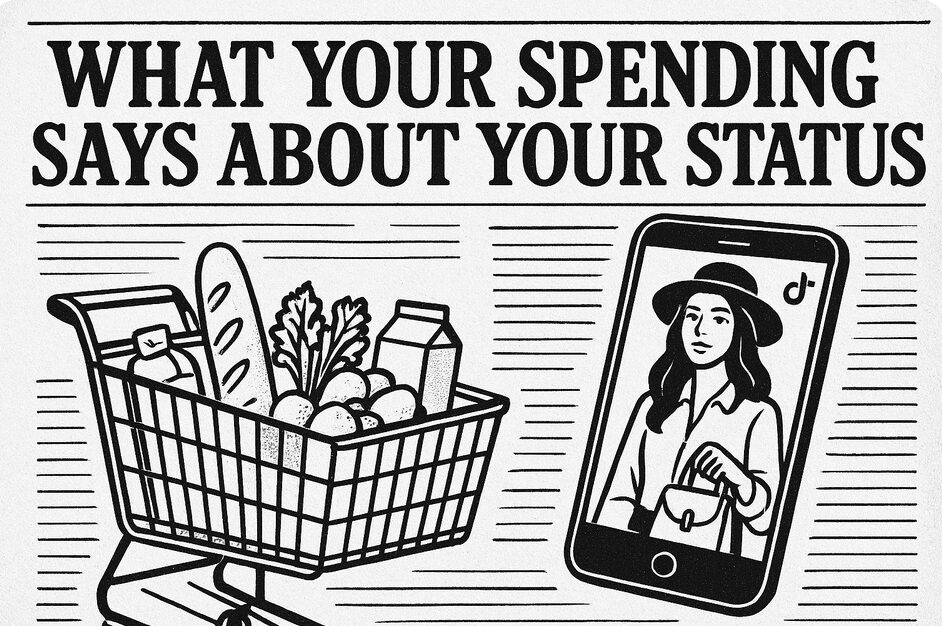![]()
![]()
Vicky Parry
23rd Oct 2025
Reading Time: 4 minutes
MoneyMagpie’s take: Class hasn’t disappeared in Britain – it’s just had a makeover, and TikTok is the glossy filter that makes it look affordable.
The Hidden Signals in Your Spending
Forget posh accents and stately homes – class in modern Britain shows up in your shopping basket. From the coffee you buy to how often you eat out, your choices reveal more about your social position than you might realise.
Sociologists call this conspicuous consumption, the idea that we use spending to show off status. Harry Wallop, in his book Consumed: How Shopping Fed the Class System, explains that British shoppers use brands as a kind of social shorthand. Choosing Waitrose over Lidl or a Barbour over a Boohoo jacket is often more about signalling belonging than practical need.
Here’s how those signals still play out today:
| Spending habit | Likely class signal | Why it matters |
|---|---|---|
| Premium groceries, niche coffee, zero-waste shops | Middle or upper-middle class | Suggests disposable income and cultural awareness |
| Designer drops, boutique fitness, flashy cars | “New money” or aspirational class | Shows status-seeking more than inherited privilege |
| Discount stores, fast fashion, meal deals | Working or lower class | Reflects financial constraint, not lack of taste |
| Art, philanthropy, luxury travel | Elite | Signals deep security and freedom from economic pressure |
But class in Britain isn’t just about income. Sociologist Dan Evans points out that you need economic, cultural and social capital to fully grasp where you stand. Someone might earn well but still feel “working class” if they lack elite education or networks.
The Great British Class Survey divided the country into seven layers, from the “elite” to the “precariat”. That study made clear that while money matters, so do your connections, tastes and cultural habits. The old “upper, middle, working” labels might sound outdated, but the class divide is still very real – just hidden beneath lifestyle choices and spending patterns.
How TikTok Makes the “New Money” Lifestyle Look Easy
If the old British class system kept people apart through birthright and etiquette, TikTok has thrown open the gates. Or at least, it looks that way. Scroll through your feed and you’ll see endless clips tagged #richkids, #oldmoneyaesthetic or #luxeathome.
A 20-year-old in a rented flat can now post a slick video of a marble kitchen or a designer handbag and seem like a millionaire. TikTok has turned wealth into performance – and anyone with good lighting can join in.
Here’s how that illusion works:
1. Luxury for everyone (sort of)
TikTok has “democratised” the look of money. You don’t need to be rich to seem rich – you just need the right filters, a Zara blazer that looks Chanel, and a few editing tricks. That accessibility fuels the fantasy.
2. The rise of the ‘old money aesthetic’
From Oxford loafers to linen skirts and library-core interiors, the “old money” look has gone viral. But as some critics point out, it often romanticises privilege and ignores who gets excluded from those circles.
Read more: The Varsity – The Problem with the ‘Old Money’ Aesthetic
3. Content equals consumption
Unboxings, hauls and luxury “get ready with me” videos have blurred the line between lifestyle and advertising. Every purchase becomes proof of success. But that also drives unhealthy comparison and impulsive spending.
4. The debt behind the display
Behind many “rich-looking” feeds are maxed-out credit cards and Buy Now, Pay Later debt. The illusion of affluence can pressure viewers to overspend just to keep up with online aesthetics.
Some creators genuinely profit from it. Mitchell Halliday, a 26-year-old from Bolton, reportedly made £1 million in 12 hours through TikTok-driven cosmetics sales, before splashing out on Louis Vuitton and Cartier.
Read more: The Times – Mitchell Halliday interview
But for most, TikTok’s version of “new money” is more performance than reality. It’s aspiration wrapped in a filter.
The Cost-of-Living Crisis Has Exposed Who Can Really Afford the Lifestyle
While TikTok makes luxury look easy, the cost-of-living squeeze tells another story. When inflation bites, all but the truly wealthy have to cut back.
A study by Grant Thornton and Retail Economics found that nine in ten UK households plan to reduce non-essential spending this year.
Read more: Grant Thornton report
Here’s what that means in real life:
- Trading down – middle-class shoppers moving from M&S to Aldi or buying supermarket own brands.
- Conspicuous non-consumption – showing restraint becomes a quiet form of status (“I don’t need to show off”).
- Dual identities – splurging on one luxury item while cutting everything else.
- Politics without class lines – divisions now fall more along age and education than income.
Read more: The Guardian – Age and Education Overtake Class in UK Politics
The MoneyMagpie Angle: Spend Smart, Not for Show
At MoneyMagpie, we always ask why you spend, not just how. Because what you buy isn’t just about taste – it’s about identity, confidence and, yes, class.
Here’s our advice:
- Don’t confuse image with wealth. A perfect kitchen doesn’t mean a healthy bank balance.
- Be intentional. Spend on things that bring joy or long-term value, not social approval.
- Know the class game. Once you understand how class shapes spending, you can decide whether you want to play by those rules – or rewrite them entirely.
Final Thoughts
Class in Britain hasn’t gone anywhere. It’s just hiding behind influencers, spending habits and filters. TikTok has blurred the line between aspiration and reality, making the “new money” lifestyle look effortless – but for most people, it’s an expensive illusion.
Understanding how and why you spend is the first step towards financial freedom, not just financial display. Real wealth isn’t in your wardrobe or your feed – it’s in your ability to make smart, secure choices that work for you.

